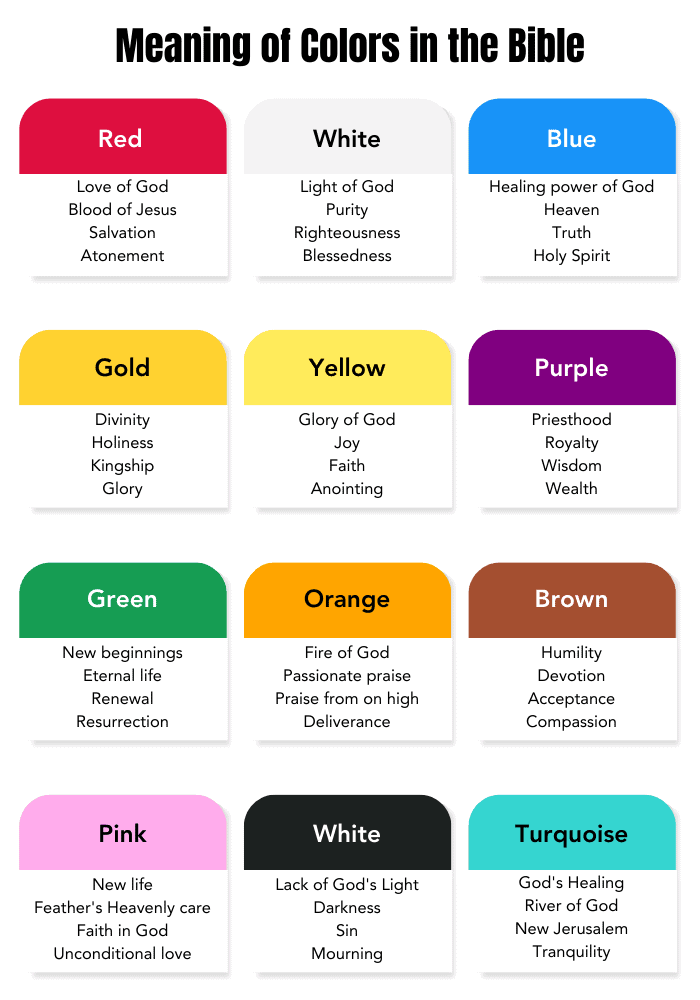Looking for the meaning of colors in the Bible? Today we will discuss the biblical meaning of each color, their connotations, and what they represent.
The Bible, a sacred scripture in most religions, has profoundly influenced art, literature, culture, and even law. That’s why it’s the most popular book in the world.
If you didn’t know before, numbers and colors hold rich symbolism in the Bible.
Today, you will learn the meaning of colors in the Bible. Interestingly, most colors have their own biblical meaning. So, you will be able to better understand the symbolism behind them.
The Significance of Main Colors in the Bible
Although almost every color has biblical meanings, the primary colors are among the most important in the Bible.
Red in the Bible
If there were a top of the colors of God, red would definitely be on top.
Red represents sacrifice, life, atonement, death, and flesh. Furthermore, red is the color that portrays the imagery of blood (John 6:55) in the form of Jesus’ sacrifice.
Also, the biblical meaning of red has additional connotations.
The Hebrew word for red, ‘Oudem,’ is linked to ‘red clay.’ Names like Adam, Esau, and Edom, which means flesh, are derived from this word, marking red as the root word for humankind.
Besides symbolizing humanity, red in the Bible represents the Blood of Jesus, the love of God, atonement, and salvation.
Yellow in the Bible
Yellow, often portrayed as gold, is associated with God’s glory and faith (Ezekiel 8:2). It also symbolizes God’s anointing and joy (for example, in Exodus 30:22-25).
The spiritual meaning of yellow is also related to purification or judgment (Hebrews 12:29 and Zechariah 13:9).
Among the negative biblical meanings, yellow can symbolize disease (Leviticus 13:30).
This meaning comes from “tsahob” – the Hebrew word for yellow, which associates the color of a sick person’s skin with this color.
But what’s the gold biblical meaning?
Gold in the Bible
Gold is associated with the love of God (for example, Ioan 3:16), as metaphorically precious as this valuable gem. In ancient times, when someone received gold they said that God poured out His love on them.
Gold symbolizes the divinity of Jesus because the Ark of the Covenant – known as the Ark of God in the Holy of Holies, although made of acacia wood, was overlaid with gold.
The negative meaning of gold in the Bible is related to falsehood. The Israelites worshipped a calf made of gold when Moses was on Mount Sinai. Also, the golden-headed statue of Nebuchadnezzar symbolized the sinful Babylonian kingdom.
So the color gold in the Bible may symbolize that material wealth can never satisfy your soul.

Blue in the Bible
Blue in the Bible is associated with the healing power of God. In Luke 8:40-48, Jesus wore a blue hem when healing a woman who had a 12-year bleeding discharge.
Moreover, blue is the color of the sky, which symbolizes heaven (Exodus 24:10) – Jesus’ heavenly home. This symbolism is reinforced in Nehemiah 9:6, reminding us of the expanse of the heavens, the earth, and the seas, and all things within them.
In Christianity, blue serves as a symbol of the divine, the celestial, and the spiritual healing power of God. So, it can be considered as one of the colors of God.
Furthermore, blue stands for truth and loyalty, indicating the Holy Spirit.
Blue is also associated with the Word of God. Likewise, Israel – God’s chosen nation – is designated as the blue of David’s time.
On the other side, light blue in the Bible symbolizes the Virgin Mary.

The Significance of Secondary Colors in the Bible
Red and blue are definitely among the most important colors in the Bible.
You can call them the colors of God. However, purple, orange, and green – the secondary colors – also play an important role.
Purple in the Bible
Purple combines red – the love of God through the sacrifice of Jesus – and blue – the healing power of God.
Furthermore, purple signifies royalty (Judges 8:26, Esther 8:15), wealth, and prosperity (Exodus 28:5, Song of Solomon 3:10, Ezekiel 27:7, Revelation 18:12) because it was an expensive pigment produced since Ancient times from the mucus of some species of Murex snail. This pigment was called Tyrian purple.
In addition, purple is associated with the holy priesthood.
But purple is also associated with purple can represent our departure from the earthly realm, symbolizing spiritual growth and transformation once we’ve received forgiveness through the love of Jesus.
The healing power of God (red) and the Word of God (blue) contribute to the wisdom of purple as a symbolic meaning in the Bible.

Orange in the Bible
The color orange in biblical symbolism is derived from mixing red, representing the sacrifice of Jesus, and yellow, symbolizing trials.
This blend creates a color similar to fire, signifying God’s purifying power, deliverance, and divine praise.
Fire, depicted as orange, is significant in both the Old Testament and the New Testament. It symbolizes the presence of God, His power, and the Holy Spirit.
Fire also represents refinement and the gift of tongues (Acts 2:3).
Specific instances of fire in the Bible include Exodus 3:2, 14:19, and Revelation 1:14, among others.
Green in the Bible
The color green results from mixing yellow, representing trials, and blue, denoting the Word of God and His healing power.
Green represents immortality, eternal life, renewal, growth, and resurrection, reflecting the vitality of nature as stated in Psalms 1:3: “The leaf shall not wither.”
The resurrection is also commemorated in spring, a season abundant with greenery and new life, as pointed out in Jeremiah 17:8.
In addition to the above, green is often linked to nations in the Bible and symbolizes fruitfulness and fertility.
Furthermore, green in the Bible underscores its connection to everlasting life and continual growth.

Other Biblical Color Meanings
White in the Bible
White represents purity, righteousness, and the light of God. White also represents the washing away of sins ( for example, Isaiah 1:18)
Additionally, it is used to portray the absolute purity of God (Daniel 7:9), of Christ (Revelation 2:17), and God’s judgment on the white throne (Revelation. 20:11).
Another symbolic meaning of white in the Bible is God’s victory over evil (Revelation 19:11), but also innocence and love – two attributes of Christ, which is why it is a predominant color in the church. Even the Pope’s robe is white.
Moreover, white is often associated with honesty and cleanliness. Verses such as Daniel 7:9, Matthew 17:2, and Mark 9:3 employ white to highlight righteousness.
The color white, being fully light and without stain, reminds us of the righteousness of Christ. It is also symbolized as wisdom in Revelation 1:14, holiness or dedication to God in 2 Chronicles 5:12, Mark 16:5, John 20:12, Acts 1:10, Revelation 4:4, 19:14, and joy in Ecclesiastes 9:8.
Thus, the color white in the Bible is a powerful symbol of purity, righteousness, and divine light, embodying the purifying power of faith and the triumph of good over evil.
Black in the Bible
Black symbolizes various forms of suffering, including mourning (Job 30), famine (Revelation 6:5), judgment due to sin (Jude 13), death (Lamentations 4:8), evil omens (Zechariah 6:2), and the grave (Job 10:21-22).
In contrast to the usual biblical representation of God’s love and power as light, black absorbs light instead of reflecting it, thus metaphorically indicating a turn away from God’s love.
This suggests that suffering often leads people to distance themselves from God or lose sight of His love.
Furthermore, black can denote eternal punishment for disobedience against God (Matthew 8:12, 22:13, 25:30) and represents a place of temporary restraint for disobedient angels (Peter 2:4). It’s also used to signify the power of evil and his ways (Acts 26:18, Thessalonians 5:5).
Brown in the Bible
In the Bible, brown is the color of God’s humanity, acceptance, and compassion (Genesis 30:24-42).
Brown symbolizes honesty and appreciation, being worn by monks as a sign of devotion and humility.
The spiritual meaning of brown is linked to humility and the earth. Still, it also means salvation (Noah’s Ark).
The ark, typically depicted as made of brown wood, was a vessel of salvation for Noah, his family, and the animals during the great flood. In this context, the ark symbolizes God’s saving grace during times of judgment.
The meaning of salvation can also be seen in the wooden cross on which Jesus Christ was crucified, which is usually depicted as brown. Thus, the cross represents the ultimate act of salvation in Christian theology, where Jesus sacrificed Himself to redeem humanity from sin.
The Meaning of Colors in the Bible
- Red: Represents the blood of Jesus, the love of God, and atonement for sin.
- Blue: Symbolic of heaven, the presence of the Holy Spirit, the healing power of God, and divine authority.
- Sapphire: Grace, divine revelation, and law.
- Purple: God’s wisdom, royalty, wealth, priesthood, and mediation between God and humanity.
- Brown: Humility, earthiness, soil, and humanity.
- Yellow: Faith, the Glory of God, anointing, and joy.
- Green: Eternal life, growth, new beginnings, prosperity, and restoration.
- Turquoise: River of God, sanctification, healing, serenity, and the New Jerusalem.
- Orange: the purifying fire of God, deliverance from hardship, and intense praise for God.
- Amber: God’s glory and the endurance of His judgment upon sin.
- Gold: The glory and divinity of God, kingship, eternal deity, righteousness, and beauty.
- Scarlet: Royalty, sinfulness (Isaiah 1:18), power to rule
- Pink: A healthy and positive relationship with God. The biblical meaning of pink can also be linked to unconditional love and faith in God.
- Silver: Salvation, divinity, redemption, truth, the word of the Lord
- Gray: Honor, wisdom, and humility.
- White: Light, righteousness, conquest, victory, joy, and peace
- Black: Lack of God’s light, humiliation, darkness, sin, death, and mourning
Did you dream in color? Find out what it means.

The significance of colors in the Bible is becoming more and more interesting as their meanings deepen different domains.
Colors are also used symbolically. For instance, white often symbolizes purity and holiness, while red can symbolize blood and sacrifice.
Not only the colors but also the numbers carry significance. The number seven, used many times in the Bible, is considered a number of completion and perfection, reflecting the world’s creation in seven days.
However, colors appear in many Bible verses, illustrating the Lord’s or Jesus’ different promises or characteristics.
The better you understand the symbolism and biblical meaning of color, the easier you understand this holy scripture.
Did you like this article about the meaning of colors in the Bible? Please share it with your loved ones.

